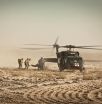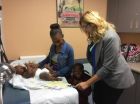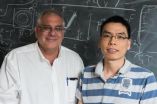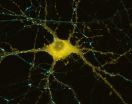(Press-News.org) Explosions are the most common cause of traumatic brain injuries in veterans returning from Iraq and Afghanistan. A new study shows that military personnel with mild brain trauma related to such blasts had outcomes similar to those with mild brain injury from other causes, according to researchers at Washington University School of Medicine in St. Louis.
However, nearly 80 percent of patients in both categories of brain trauma suffered moderate to severe overall disability within a year after injury.
The analysis appears June 16 in JAMA Neurology.
"We are interested in whether there are fundamental differences between the effects of concussions caused by a blast versus other kinds of blunt head trauma," said senior author David L. Brody, MD, PhD, associate professor of neurology. "This study and others make us a bit skeptical of the notion that the long-term effects of blast injury to the brain are somehow unique.
"We still think the physics of how a blast interacts with the brain is quite different from other kinds of brain trauma," he added. "But we have yet to find the consequences of that — if there are any — for patients."
About 20 percent of U.S. forces in Iraq and Afghanistan are estimated to have experienced a head injury during deployment. Of those injuries, about 83 percent are considered mild forms of traumatic brain injury or concussion.
The researchers examined 255 U.S. military personnel who were injured while on active duty in Iraq and Afghanistan. All were evacuated to Landstuhl Regional Medical Center in Germany.
To assess long-term outcomes, the investigators were able to evaluate 178 patients six to 12 months later. Of these, 53 had mild traumatic brain injury involving an explosion and 29 had mild traumatic brain injury unrelated to a blast. As a comparison, the study also included 27 military personnel with blast exposure (meaning they felt the force of an explosion) but no brain injuries and 69 with no blast exposure who were evacuated for medical reasons other than brain injury.
"For our patients with blast-related concussions, I want to emphasize that the explosion was always in combination with another event, such as a motor vehicle crash, a fall or an object striking the head," Brody said. "It's important that we're mostly studying the combination of blast plus impact, compared to impact alone. Blast injury alone — without a secondary impact — appears to be extraordinarily rare."
Comparing the two groups with traumatic brain injury (blast- versus nonblast-related), the research team saw no difference in overall disability, with 77 percent of the blast group suffering moderate to severe disability compared with 79 percent of the nonblast group. They also saw no differences between these groups in severity of headaches, depression, post-traumatic stress disorder (PTSD) and performance on cognitive tests. That was despite the fact that the blast-related group reported seeing significantly more active combat.
"In patients with brain injury, combat exposure by itself did not seem to correlate with the high rate of PTSD or depression or the other measures we reported," Brody said.
Both brain injury groups showed worse overall disability compared with the two control groups evacuated for medical reasons unrelated to concussions. In contrast to the brain injury groups, 59 percent of the blast-without-head-injury group experienced moderate to severe disability as did 41 percent of the group that had experienced no blasts and no head injuries.
The group exposed to a blast without head injury had elevated rates of PTSD and headaches compared with the group with no blasts and no head injuries. But they were still better off than the two groups with head injuries.
"This may suggest an additive effect, where blast exposure and combat exposure combined have some effect, and brain injury on top of that has additional influence on PTSD and other outcome measures," Brody said.
The investigators, including first author Christine L. MacDonald, PhD, now at the University of Washington in Seattle, also observed that both brain injury groups, even those unexposed to explosions, had much higher rates of disability compared with civilians suffering concussions. To explain these worse outcomes, they note the possibility of active military duty itself playing a role, rather than the physical injury alone.
"Poor outcomes appear to be associated most strongly with having a traumatic brain injury while on active military duty," Brody said. "It's also possible these brain injuries in military personnel that resulted in medical evacuation were more severe than we typically see in a civilian population. After a sports-related concussion, for example, many people make a good recovery over several weeks."
Brody said the researchers' next step in understanding whether blast-related brain injury is unique is to examine military personnel whose brain injuries were mild enough to allow a return to active duty, a situation that is perhaps more similar to typical civilian concussions.
INFORMATION:
This work was supported by a grant from the Congressionally Directed Medical Research Program (Grant number PT090444).
MacDonald CL, Johnson AM, Wierzechowski L, Kassner E, Stewart T, Nelson EC, Werner NJ, Zonies D, Oh J, Fang R, Brody DL. Prospectively assessed clinical outcomes in concussive blast vs. nonblast traumatic brain injury among evacuated U.S. military personnel. JAMA Neurology. June 16, 2014.
Washington University School of Medicine's 2,100 employed and volunteer faculty physicians also are the medical staff of Barnes-Jewish and St. Louis Children's hospitals. The School of Medicine is one of the leading medical research, teaching and patient-care institutions in the nation, currently ranked sixth in the nation by U.S. News & World Report. Through its affiliations with Barnes-Jewish and St. Louis Children's hospitals, the School of Medicine is linked to BJC HealthCare.
In military personnel, no difference between blast and nonblast-related concussions
2014-06-16
ELSE PRESS RELEASES FROM THIS DATE:
How to prevent disparities in colon cancer screening
2014-06-16
SEATTLE—People living in poverty are less likely to be screened regularly for colorectal cancer—and more likely to develop the disease and die from it. How to end these disparities—and raise screening rates, lower disease rates, and prevent deaths? A promising way is to mail fecal immunochemical tests (a newer kind of stool test) to populations, Beverly B. Green, MD, MPH, and Gloria D. Coronado, PhD, wrote in the June 17 JAMA Internal Medicine.
Dr. Green is a Group Health physician and an associate investigator at Group Health Research Institute. Dr. Coronado is a senior ...
When patients wish for a miracle, tool helps medical staff say 'amen'
2014-06-16
Cancer clinicians and a chaplain at the Johns Hopkins Kimmel Cancer Center have developed a new tool to help doctors, nurses and other health care providers talk to dying patients and families who are, literally, praying for a miracle.
The AMEN (Affirm, Meet, Educate, No matter what) protocol, a script that can be used by medical staff, offers a way to negotiate these challenging conversations to affirm or acknowledge a patient's hope, share the patient's wish with others, continue to educate the patient and family about medical issues, and assure them that their health ...
Redesigning the well-child checkup
2014-06-16
Well-child visits are the foundation of pediatric primary care in the U.S. Accounting for more than one-third of all outpatient visits for infants and toddlers, the appointments are intended to give doctors the opportunity to identify health, social, developmental and behavioral issues that could have a long-term impact on children's lives.
However, several studies have shown that the current system of well-child care leaves room for improvement. One major concern is that well-child care guidelines issued by the American Academy of Pediatrics call for physicians to provide ...
Many bodies prompt stem cells to change
2014-06-16
HOUSTON – (June 16, 2014) – How does a stem cell decide what path to take? In a way, it's up to the wisdom of the crowd.
The DNA in a pluripotent stem cell is bombarded with waves of proteins whose ebb and flow nudge the cell toward becoming blood, bone, skin or organs. A new theory by scientists at Rice University shows the cell's journey is neither a simple step-by-step process nor all random.
Theoretical biologist Peter Wolynes and postdoctoral fellow Bin Zhang set out to create a mathematical tool to analyze large, realistic gene networks. As a bonus, their open-access ...
Researchers create better methods to detect E. coli
2014-06-16
MANHATTAN, KANSAS — Kansas State University diagnosticians are helping the cattle industry save millions of dollars each year by developing earlier and accurate detection of E. coli.
Lance Noll, master's student in veterinary biomedical science, Greensburg; T.G. Nagaraja, university distinguished professor of diagnostic medicine and pathobiology; and Jianfa Bai, assistant professor in the Kansas State Veterinary Diagnostic Laboratory, are leading a project to improve techniques for detecting pathogenic Shiga toxin-producing E. coli O157:H7. A U.S. Department of Agriculture ...
Getting rid of old mitochondria
2014-06-16
It's broadly assumed that cells degrade and recycle their own old or damaged organelles, but researchers at University of California, San Diego School of Medicine, The Johns Hopkins University School of Medicine and Kennedy Krieger Institute have discovered that some neurons transfer unwanted mitochondria – the tiny power plants inside cells – to supporting glial cells called astrocytes for disposal.
The findings, published in the June 17 online Early Edition of PNAS, suggest some basic biology may need revising, but they also have potential implications for improving ...
Discovery of Earth's northernmost perennial spring
2014-06-16
Boulder, Colo., USA – A Canadian team lead by Stephen Grasby reports the discovery of the highest latitude perennial spring known in the world. This high-volume spring demonstrates that deep groundwater circulation through the cryosphere occurs, and can form gullies in a region of extreme low temperatures and with morphology remarkably similar to those on Mars. The 2009 discovery raises many new questions because it remains uncertain how such a high-volume spring can originate in a polar desert environment.
Grasby and colleagues encountered the northernmost perennial ...
Pathological gambling runs in families
2014-06-16
A study by University of Iowa researchers confirms that pathological gambling runs in families and shows that first-degree relatives of pathological gamblers are eight times more likely to develop this problem in their lifetime than relatives of people without pathological gambling.
"Our work clearly shows that pathological gambling runs in families at a rate higher than for many other behavioral and psychiatric disorders," says Donald W. Black, MD, professor of psychiatry in the UI Carver College of Medicine. "I think clinicians and health care providers should be alerted ...
Low dose of targeted drug might improve cancer-killing virus therapy
2014-06-16
COLUMBUS, Ohio – Giving low doses of a particular targeted agent with a cancer-killing virus might improve the effectiveness of the virus as a treatment for cancer, according to a study led by researchers at The Ohio State University Comprehensive Cancer Center – Arthur G. James Cancer Hospital and Richard J. Solove Research Institute (OSUCCC – James).
Viruses that are designed to kill cancer cells – oncolytic viruses – have shown promise in clinical trials for the treatment of brain cancer and other solid tumors. This cell and animal study suggests that combining low ...
How our brains store recent memories, cell by single cell
2014-06-16
Confirming what neurocomputational theorists have long suspected, researchers at the Dignity Health Barrow Neurological Institute in Phoenix, Ariz. and University of California, San Diego School of Medicine report that the human brain locks down episodic memories in the hippocampus, committing each recollection to a distinct, distributed fraction of individual cells.
The findings, published in the June 16 Early Edition of PNAS, further illuminate the neural basis of human memory and may, ultimately, shed light on new treatments for diseases and conditions that adversely ...







